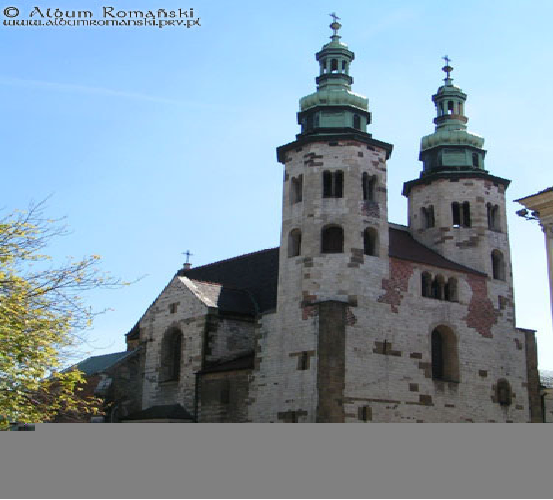Title of Product:
Architecture of XII century: the St. Andrew’s Church in Cracow – the plot of vivid details
Country:
 Poland
Poland
Century: 1100 - The 12th Century
Topic: St. Andrew’s Church in Cracow
Image of the product:

Name of Author(s): Malgorzata Fugiel-Kuzminska
Name of Producer: Net periodic: albumy.pl
Language/s of Product: Polish
Target Group: General audience
Overall Evaluation: excellent
Availability of community:
Newsgroup
Objectives & Structure:
Aspects to consider:
- Deep analysis of history and thematic roots
- Passion for the hidden history and human motivation in the art’s subject
- Sacral architecture, sacral order
- Distinguishing various architectural details within the thematic plots/puzzles
Description of contents:
BY THE GRODZKA STREET 56 there is situated that church. It was founded by Wladysław Herman’s palatinate- Sieciech. It was being built in the years: 1079- 1098 and had a protective destination. This is why it was called “Lower Castle”. It could be successfully composed itself as a central building of Okol (a village situated between the old Cracow and Wawel). Since 1318 that church has belonged to the female monastery of St. Clara, the oldest female monastery in Cracow.
The St. Andrew’s Church was many times destroyed, rebuilt and reconstructed, this is why one can observe a significant contrast between the Roman Style building’s shape and its Baroque inside. Not too much has preserved there from the Roman Style, and that what still exists is practically not touchable. The monastery has very strict rules of functioning, and the church may be watched only through the bars. Probably, in the staircase of the northern Tower, there has preserved a signature of the builder from XII century, and in the southern part of the church there exist Roman Art paintings from XII century (the oldest frescos in Cracow). The monastery has also other priceless masterpieces- a late Roman Style’s gradual from the first half of XIII century. In such circumstances, visitors may only watch the church from the outside. And just there, it is really expressional. It composes a monumental protective building (the walls are 1.6 metre thick!), possessing 3 naves and 2 towers. The basilica’s arch is preceded by transept.
Between the western towers one can distinguish an emporium (maybe there are also others on the sides?), the presbytery is typically closed with an apse, which is richly decorated on the outside. Not only the thick walls suggest the protective character of the church, but also highly located windows. There have also preserved the arched molding, biforia in the towers and the triforium on the western wall.
Evaluation and Comments:
Overall Evaluation: excellent
Clarity of structure, logical sequence of contents: excellent
Usability / easiness of navigation: excellent
The website is interesting / stimulating: excellent
Educational and learning value: excellent
Quality and relevancy of content: excellent
Compatibility of the content with the target group: excellent
Suitability and quality of graphic interface: excellent
Degree and quality of interaction: excellent
Exploitation of the electronic potential: excellent
Availability and quality of simulation exercises: excellent
Quality of the evaluation tools: excellent
Possibility of printing/saving material or tests: excellent
Description of how the website can be used with the students::
The students find the history as the source of vivid ideas in the world of religious belief and engagement
They can develop the ideas of architecture through the pattern of sacral expression
Comments::
The cascade of the styles and in- between borrowings can be widely discussed here
Evaluation Date: 01.09. 2008
Name of teacher: Michał Seroczyński
Name of School: Centre for Continuing Education
Country: Poland
Subjects Taught: Fine Arts
Comments about this product

 Poland
Poland